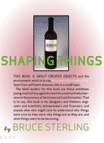schoenerwissen OfCD
"Shaping Things is about created objects and the environment, which is to say, it's about everything. Seen from sufficient distance, this is a small topic," writes Bruce Sterling.
Sterling offers a brilliant, often hilarious history of shaped things. We have moved from an age of artifacts, made by hand, through complex machines, to the current era of "gizmos." New forms of design and manufacture are appearing that lack historical precedent, he writes; but the production methods, using archaic forms of energy and materials that are finite and toxic, are not sustainable. The future will see a new kind of object -- we have the primitive forms of them now in our pockets and briefcases: user-alterable, baroquely multi-featured, and programmable -- that will be sustainable, enhanceable, and uniquely identifiable. Sterling coins the term "spime" for them, these future manufactured objects with informational support so extensive and rich that they are regarded as material instantiations of an immaterial system. Spimes are designed on screens, fabricated by digital means, and precisely tracked through space and time. They are made of substances that can be folded back into the production stream of future spimes, challenging all of us to become involved in their production. Spimes are coming, says Sterling. We will need these objects in order to live; we won't be able to surrender their advantages without awful consequences.
The vision of Shaping Things is given material form by the intricate design of Lorraine Wild. Shaping Things is for designers and thinkers, engineers and scientists, entrepreneurs and financiers -- and anyone who wants to understand and be part of the process of technosocial transformation.
Hugo Award-winning science fiction author and futurist Bruce Sterling has been called by Time "perhaps the sharpest observer of our media-choked culture working today in any genre." Three of his novels have been New York Times Notable Books of the Year, and he has been a contributing writer for Wired since its conception. In 2005 he is "Visionary-in-Residence" at Art Center College of Design, Pasadena.
*
*
*
*
*
"Shaping Things is a manifesto for the future of design, impeccably crafted by Bruce Sterling and enhanced by the delicately emphatic graphic intelligence of Lorraine Wild.
The science fiction writing of Bruce Sterling appeals to a broad audience, but the edgy near-reality of his style holds particular fascination for people who understand design. In Shaping Things he hovers between science fiction and design fact, pushing forward into the future and showing how design happens.
He offers insights about design with ringing phrases like "Designers mine raw bits of tomorrow" and explanations of the processes of brainstorming, synthesis and rapid prototyping. He introduces a hierarchy of change as we move into the future, labeled by neologisms such as "arphid" (meaning RFID tags), implying that we "no longer hunt
anxiously for missing shoes in the morning, we just Google them."
At the top level of his hierarchy is the "SPIME," described as "a set of relationships first and always, and an object now and then," and "a digital mob of tiny, low cost advantages and mistakes." He strikes further into the future by describing the merging of object and person, as the "SPIMES" become one with the people who manipulate them. He predicts that this will happen around 2070, but may be full of "unpredictable urges that spring up like hurricanes from a butterfly's sneeze."
— Bill Moggridge, Cofounder of IDEO

View selected spreads from the book with the

Visit the WebTake...